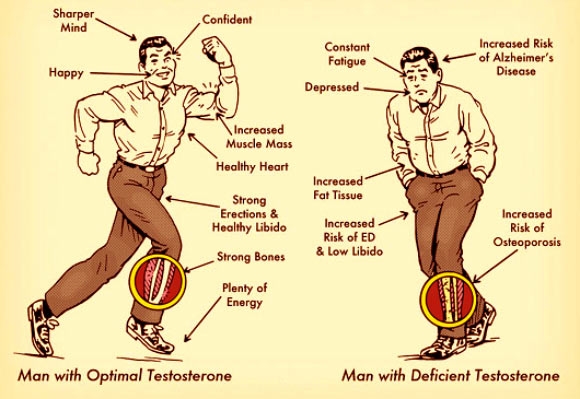
My story may be a very familiar one for men that experience low energy levels or fatigue throughout the day. Even though I am active in health and fitness, for years I have had the feeling of “exhaustion”. I mostly attributed this feeling to getting older and a busy lifestyle. I certainly had great excuses for being tired with young kids at home, significant travel and building a home-based business while still working full-time. And, to compensate, I often tried different sources for artificially enhancing energy levels such as unhealthy energy drinks (just because Monster Lo Carb is “low carb” that does not make it healthy!). Although age and lifestyle may certainly contribute to feeling worn down, another potential root cause of these symptoms may be low testosterone levels. As such, I recently investigated my T levels FOR THE FIRST TIME and I was shocked at the results!
My Total Testosterone when measured was 335 ng/dL. The range for “healthy” testosterone was reported by my doctor to be between 240 – 871 ng/dL. I was told I was in range and should not be concerned. I was not convinced, that value seemed low to me. Very low. As a science guy I decided to do some research and found A LOT of data on testosterone levels by age. The chart and table below are a great summary of the type of information I commonly found in my searches.
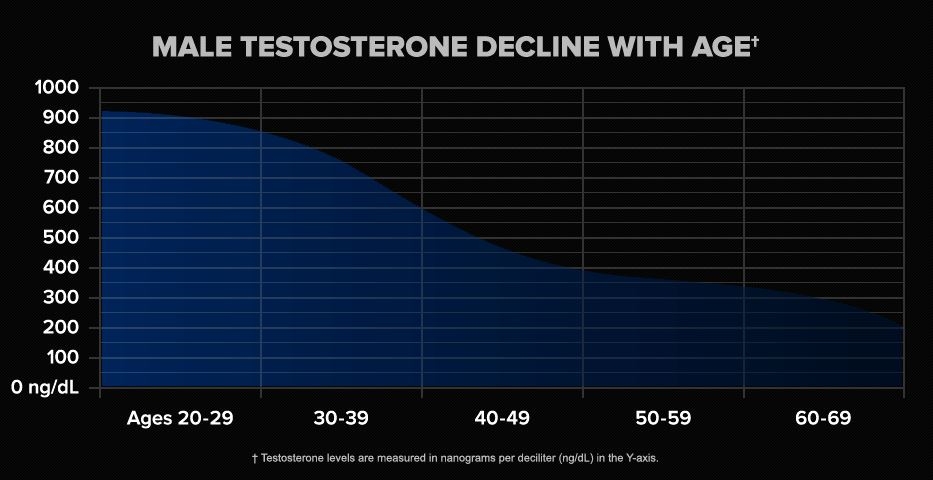

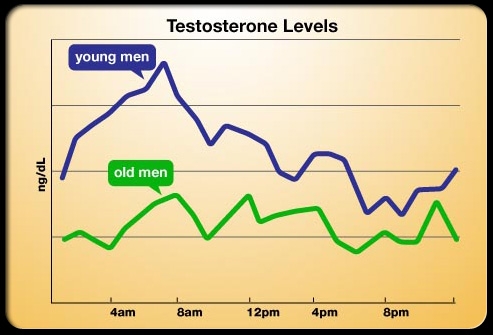
So, yes, 335 ng/dL is within range…
FOR A 60 – 100 year old male!
(My test was conducted in the morning when T levels are generally the highest during the day.)
I am closing in on 40 years old so my testosterone levels should be closer to 600 ng/dL based on most data. It is also possible based on studies that my low T levels may correlate to lower bone density, which in turn may have been one of the root causes of my lower back herniation and degeneration from X-Ray/MRI last year. Certainly just a theory though. Anyway, I was excited with this revelation as it gave me hope for opportunities to improve my lifestyle by simply increasing my testosterone.
How do you increase testosterone?
There are numerous studies, theories and ideas, but generally you may be able to primarily influence your T levels via…
- Lifestyle – Nicotine from smoking inhibits and reduces T levels
- Diet – Need enough fat intake per day (recommended 30% total calories from healthy fats) and sufficient vegetables to increase free circulating testosterone
- Sleep – Testosterone elevates with proper sleep, at least 7-9 hours per day
- Stress – Increases cortisol and decreases testosterone
- Exercise – Compound movements best to stimulate T production
- Genetics – Apparently some families are pre-disposed to low testosterone
- Certain treatments – Pills, injections and implants, for example
As mentioned, I lead a relatively active and healthy lifestyle. I do not smoke. My daily nutrition targets are around 30% calories from healthy fats such as nuts, fish, olives, avocados, etc. Since retiring from the Corporate World and becoming full-time self-employed parent from home, my sleep has improved to average 8+ hours per night. Low testosterone does not run in my family, as far as I know.
My stress levels are much better than prior, but perhaps stress is a factor for me with young kids at home and my own business. Exercise should not be an issue, but I am still in the process of recovering from a lower back disc herniation. I was idle for a few months last year, so maybe that was a contributing factor to my low T levels (perhaps they dropped significantly and I still have not recovered?). My back is better now. Fitness is my passion and I have been staying active at least 5 days per week, consistently, for many years.
With that, other than staying focused on the factors I can control including my sleep, stress levels, diet and exercise, I thought I would also explore other options for enhancing or promoting healthy testosterone levels for my age.
I did not consider yet some of the opportunities to enhance testosterone prescribed from doctor intervention, mostly since I wanted to first try an over-the-counter option. Besides, my doctor believed my testosterone did not require intervention. I did not consider at this time direct and regular injections, pellet implants that gradually release into the bloodstream over time, patches, gels and concentrated oral pills to enhance T levels. What I did consider in this first investigation was simple over-the-counter pills to “support” healthy testosterone levels.
There are numerous supplements on the market to support healthy testosterone. Based on my research I decided to try Weider Prime Healthy Testosterone Support for Men (also conveniently available in 2-month supply for less than $30 at Costco).
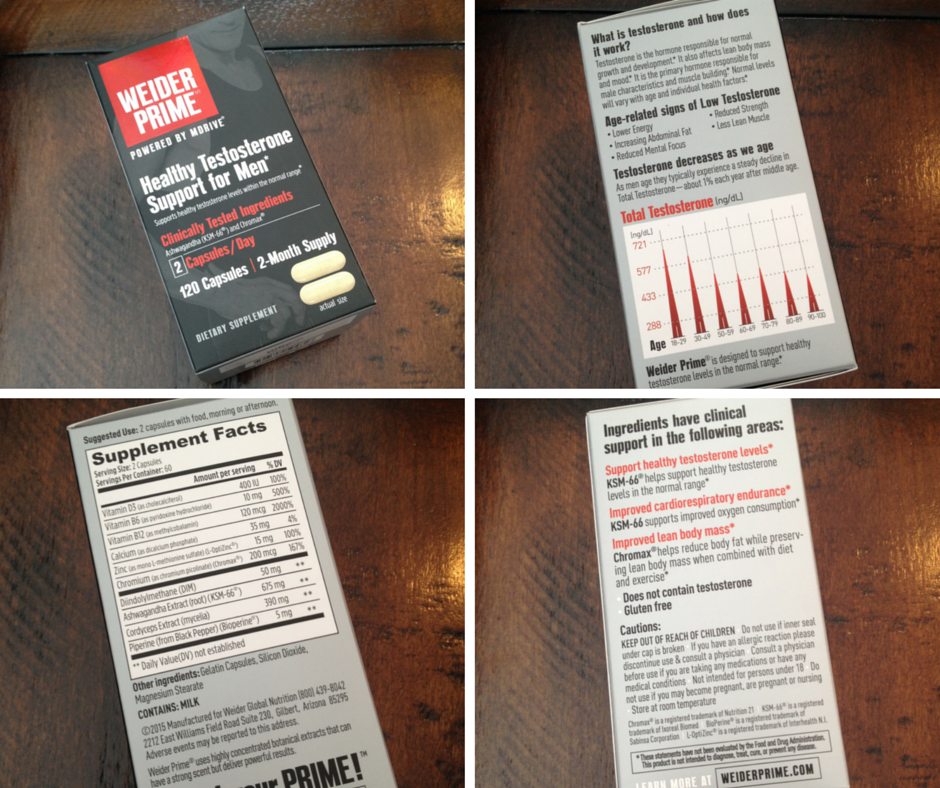
The science behind how the Weider Prime and other pills “support” healthy testosterone are elusive, but Weider Prime promotes the following…
There are 3 ingredients considered by Weider Prime Testosterone Support to be the primary active go-to ingredients.
Each has undergone clinical testing that Weider Prime Testosterone Support proudly points to.
They are:
- KSM-66.This is a very concentrated extract of Ashwagandha with a higher potency than any other Ashwagandha on the market.It acts as an adaptogen which means it boosts the body’s ability to respond appropriately to physical and/or mental stressors.It does this while also supporting healthy testosterone levels.
- Chromax.This derivative of Chromium Picolinate helps reduce fat and preserve lean muscle mass.Its primary mechanism of action is that it improves your body’s metabolism of carbohydrates.
- Bioperine.This form of black pepper has been clinically shown to increase the bioavailability of other ingredients within a supplement, making the supplement as a whole more effective.
Additional supporting ingredients in the formula include:
- Cordyceps, which has been used in Chinese medicine for centuries.It enhances energy and improves athletic performance.
- Zinc, which has a positive correlation with increased testosterone within the body.In blood tests, higher zinc levels are often present alongside higher testosterone levels.It also supports a healthy immune system.
- DIM (Diindolylmethane), which helps maintain the right balance between estrogen and testosterone.
- Vitamin D3, which increases proper absorption of calcium and phosphate, leading to improved testosterone levels.
- Vitamin B6 and B12, which provide all day energy without the crash, as well as antioxidants to protect cells from free radical damage.
Great. I have no idea, seems like a lot of marketing hype. Anyway, I see a lot of potential benefits in the ingredient list and thought I would give it a try for 4 months along with my continued focus on ramping exercise, diet, sleep and reducing stress. After 4 months, I re-tested my total testosterone and also free testosterone. The result….
Total Testosterone = 590 ng/dL with normal range 240 – 871 ng/dL
Free Testosterone = 11.21 ng/dL with normal range 1.39 – 17.69 ng/dL
Wow. My Total Testosterone increased from 335 ng/dL to 590 ng/dL for a net of 255 points in 4 months, now in normal range for my age!! Holy smokes. Free testosterone levels are normal as well.
Now, I am not promoting Weider Prime as the magic pill to cure low testosterone levels and fatigue (and maybe other symptoms). Perhaps there is merit to enhancing body chemistry and mechanisms with testosterone support. The results here are undeniable. With recognition that this significant increase in T levels could ALSO be attributed to many complex factors like specific diet and exercise, I decided to stop taking the testosterone support to see what happened.
It has now been a month since I stopped taking Weider Prime and I have experienced noticeable fatigue in the past month again even though I have maintained proper exercise, stress, sleep and nutrition (I have not re-checked testosterone levels). Seem to be on to something here. As such, I decided to start back on the testosterone support today and will check back with updates on my energy levels. Ditching proper science protocol where I likely would have re-checked T levels after being off the support, I just want to feel better during the day and decided to resume support to see if I have similar results again.
UPDATE 12/10/2016: After I cycled back on Weider Prime for several months I decided to cycle off again and get my testosterone levels re-checked to capture additional data on the supplement. I really wanted to understand how my actual T-numbers were effected by Weider Prime. I cycled off and then re-measured my TOTAL and FREE testosterone levels. See the summary below. Wow. The data certainly appears to indicate that the testosterone support really appears to be doing something for me! The data points highlighted in the green box show that both TOTAL (blue line) and FREE (red line) testosterone dropped back to earlier values after cycling off the supplement (FREE was not checked in 2015). Alrighty then, looks like I am cycling back on Weider Prime.
UPDATE Summer 2017: My testosterone levels have since stabilized and I no longer take any T boost supplements. There is hope!
If you struggle with low energy levels, fatigue or symptoms shown in the image at the top of this blog article, perhaps you may consider checking testosterone levels for your age. The test does not have to be expensive and may even be covered by your insurance. If low, you may want to consider some over-the-counter options to enhance healthy testosterone. Hope this helps at least one person feel better, like me!!

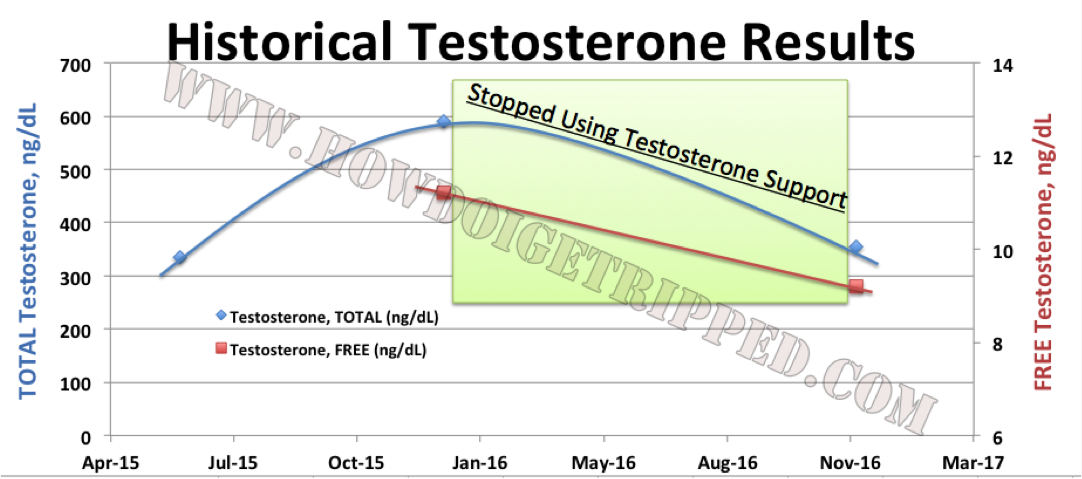
I am an ER physician DX (Diagnosed) with a Carnitine myopathy, and while I am on testosterone, if there is a delay in filling my RX and my Testerone level decreases, my muscle disease worsens.
Thank you for sharing your experience and I wish you all the best. I appreciate you checking out my website!